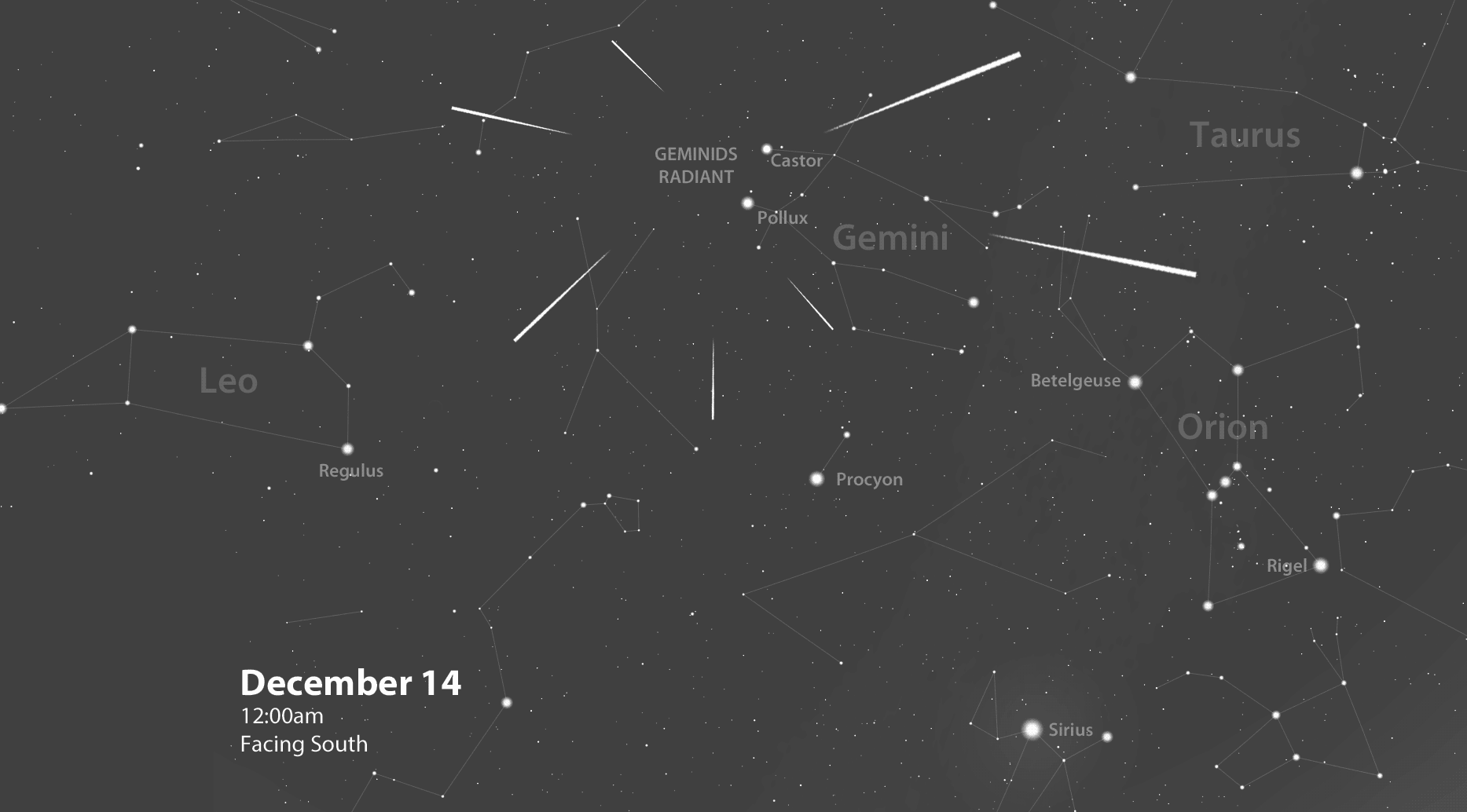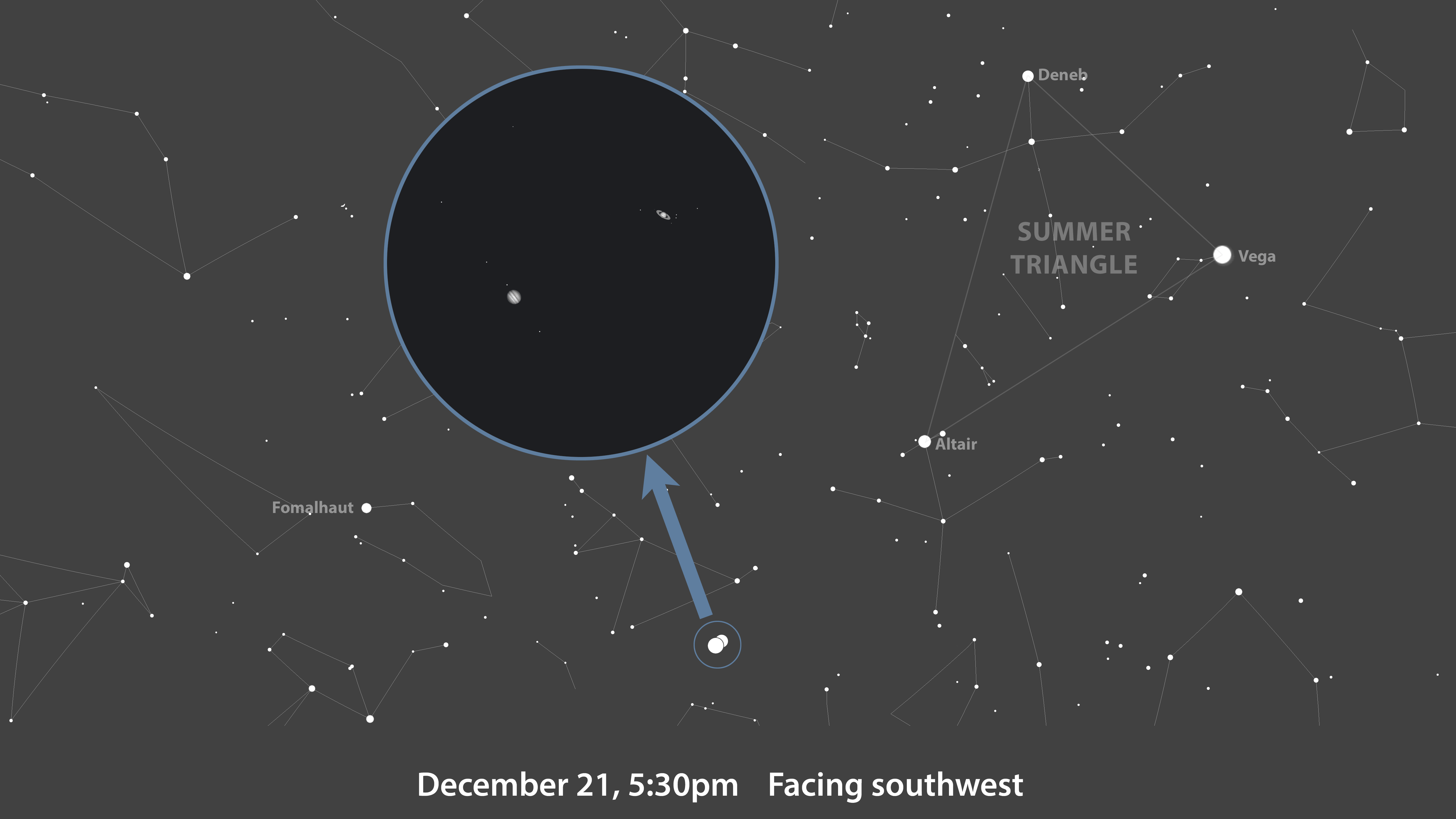
The Geminid Meteor Shower & the Great Conjunction of Jupiter and Saturn
December 2020 :
Note: This article may contain outdated information
This article was published in the December 2020 issue of The Skyscraper and likely contains some information that was pertinent only for that month. It is being provided here for historical reference only.
2020 has been disastrous for the local observatories. Seagrave and Ladd have been closed since mid-March due to Covid-19, thereby preventing stargazers from enjoying splendid views of the heavens from these great facilities. In addition, for me the pandemic forced my retirement from teaching astronomy labs at Bryant University after a great ten-year run of enlightening students about basic astronomical concepts. Although I hate to hasten the passage of time any quicker than it appears to be running at present, I for one will be glad to see 2020 in the rearview mirror.
Regrettably, I believe it will be at least mid-year 2021 before we will be able to gather safely as a group to explore the heavens as we did BC (Before Covid). Until that time I will continue to provide you with news of astronomical events that can be observed either with your naked-eye or with small personal telescopes. The skies above are available for your exploration any clear night from the relative safety of your own backyard. There is something for everyone if you know what to look for and when. While my monthly columns can only highlight a couple of interesting astronomical events, there are many websites out there that can provide something of interest for practically every night. Here are a handful to get you started (some may require you to input the current year):
- http://www.seasky.org/astronomy/astronomy-calendar-2020.html
- https://in-the-sky.org/newscal.php
- https://www.timeanddate.com/astronomy/sights-to-see.html
December has three major events on which I would like to focus. First up is the annual Geminid meteor shower on the night of December 13-14. The Geminids are the most reliable and productive display of shooting stars observed from the northern hemisphere. The Earth sweeps through a stream of debris deposited in the orbital path of a two-mile-in-diameter hybrid “rock comet” named 3200 Phaethon. And this year the Moon will be in its New phase and will not interfere whatsoever with observing as many meteors as possible.

If the weather cooperates, the dark moonless night will permit stargazers well away from interfering light pollution to observe 60+ meteors per hour at peak sometime between 10 p.m. and dawn’s early light. While the Geminids appear to radiate from Gemini near its brightest stars, Castor and Pollux, scan around the sky as much as possible. As the night progresses and Gemini moves across the sky towards the west, your scan should move as well. At around 2:30 a.m. Gemini will be on your north/south meridian, just south of zenith. The number of meteors per hour should increase throughout your observing session. You’ll know you’ve seen a Geminid if you can trace the origin of the meteor’s trail back to the radiant point.
The Geminids are fairly bright and moderate in speed, hitting our atmosphere at 21.75 miles per second. They are characterized by their multicolored display (65% being white, 26% yellow, and the remaining 9% blue, red and green). Geminids also have a reputation for producing exploding meteors called fireballs.
Keep in mind that the Geminid meteor shower is one shooting star display that can be observed before the midnight hour. In fact, earlier in the evening of the 13th, you might spot a few Geminid earth grazers as they skim tangentially across the top of Earth’s atmosphere and parallel to the horizon. This scenario provides for much longer streaks, often looking like a stone skipping across a pond.
Good luck and remember to stay warm.
It doesn’t seem possible that winter is nearly upon us in the northern hemisphere. On the 21st the Winter Solstice occurs at 5:02 a.m. EST (Eastern Standard Time). Notice how far south along the eastern horizon the Sun rises. Then observe how far south along the western horizon the Sun sets. The apparent shift of the Sun’s position in the sky throughout the year is the result of the Earth’s fixed axial tilt of 23.5 degrees as our planet orbits the Sun. Read my article on The Reason for the Season(s) on the Skyscrapers’ website: http://www.theskyscrapers.org/reason-for-the-seasons. Then watch the following video for a review of this movement: https://youtu.be/d6rgyJkrMXg. After the solstice, daylight hours grow longer as the angle the Sun rises and sets along our horizon increases as the Sun migrates northward in our sky.
While the close approach of Mars to the Earth two months ago was exciting, two other planets wanted to share the spotlight in 2020. I’m talking about the Great Conjunction of Jupiter and Saturn on night of the 21st. Throughout the year these two planets have been moving closer to each other in the sky from our Earthly perspective. On the night of the 21st they will be so close that they will appear as one object to the naked-eye just after sunset 15 degrees above the southwestern horizon. In reality, Jupiter will be approximately 551 million miles from the Earth, whereas Saturn will be approximately just over one billion miles away. This “Great Conjunction” will be the closest these two worlds have been since 1623, and will be a spectacular phenomenon to behold.

To observe this event, you’ll need to find an observing location that commands an unobstructed view towards the southwest. If you have a telescope by all means use it to focus in on this beautiful sight. Use medium-to- high power and you’ll observe both worlds in their glory in the same field of view. Jupiter’s four Galilean moons will be visible, with Callisto, Io and Ganymede on one side of the planet’s disk, while Europa all by itself on the opposite side. Saturn’s ring system will be very stunning, and his largest moon Titan will also be visible.
Hopefully the weather will cooperate, as the next Jupiter/Saturn conjunction on November 5, 2040 won’t be as “Great.” This event is really something special to note on your calendar.
Keep your eyes to the skies.
Happy Holidays!



